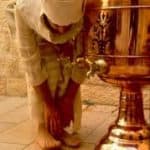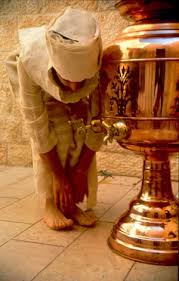
Moshe Kempinski
In honor of the Shabbat Bar Mitzva of Noam Elnatan ben Yonatan Shalom
Life Lessons from the Torah Portion
Parshat Ki Tisa Exodus 30:11-34:35
After asking that each member of the community of Israel to bring a half shekel for the construction of the tabernacle, the Kohanim ( the Priests) are then commanded the following
Hashem spoke to Moshe ( Moses), saying “You shall make a washstand of copper and its base of copper for washing, and you shall place it between the Tent of Meeting and the altar, and you shall put water therein. Aaron and his sons shall wash their hands and feet from it. When they enter the Tent of Meeting, they shall wash with water so that they will not die; or when they approach the altar to serve, to make a fire offering rise up in smoke to Hashem ( Exodus 30 17-20)
Then we read of that warning repeated;
“they shall wash their hands and feet so that they will not die; this shall be for them a perpetual statute, for him and for his descendants, for their generations.”( ibid:21)
What was the life and death importance of the washing of the hands and feet?
That is important to explore because it is a service that is re-enacted in every Torah Jew’s life throughout every single day of his or her life .When we wake in the morning, it is the first action we take and one of the first blessing we recite in our morning prayers. Before partaking of bread, the staple of life, we re-enact that same ritual. After leaving a washroom and re-entering life or after any action that carries a hint of decay or mortality (leaving a grave site, haircutting or nail cutting), the same ritual is performed by every individual, Kohen , Levite or Israelite. It is a ritual practiced by many before prayer or Torah study. It is in fact a ceremony that is so pervasive in much of our torah based life. The second question to ponder is why would that be?
One final question to explore would be to determine if there is any significance to the fact that the vessel used for handwashing is the last Temple utensil described and that its description is placed prior to the Sin of the Golden Calf.
Let us begin with that final question.
The people of Israel experience the revelation of the Divine and yet soon after, fall into the sin of the golden calf. How could that have happened?
It is usually assumed that that their sin was a sin of idolatry and of creating “other gods”. Yet clearly the children of Israel were not trying to replace G-d but rather they felt a compulsion to replace Moshe (Moses) their leader and teacher.
On the 16th of Tammuz the people come to the mistaken conclusion that Moshe is overdue and that perhaps he has died. “When the people saw that Moshe had not come down the mountain, they gathered round Aaron and said to him, ‘come make for us gods to go (Yeilchu-plural verb) before us [to lead us]; for that man [Moshe] who brought us here from Egypt – we do not know what has become of him’.” (ibid 32:1)
Yet Aharon, Moshe’s brother extracts the golden calf out of the fire in order to stall for time and then some of the people declare;
“…, these are( Eleh) your gods, O Israel, which brought you up out of the Land of Egypt.” (Exodus 32:4)
The use of the plural word ELEH is critical to our understanding. G-d still remained G-d and the calf was only meant to replace Moshe . They felt that they needed to have some other entity to stand between them and the Ultimate and fearsome G-d if Moshe was not going to return from the Mount.
In the delicate moments of Mankind’s feelings of mortality, we yearn to find the rituals, the symbols or the words that would provide some solace or protection .To the children of Israel who had just escaped from Egypt, Moshe (Moses) represented a shortcut to salvation.
Hashem expected much more from them.
This same mistake could have been made by the Kohanim ( the Priests) entering the temple. We are aware that in preparation to do the work of the temple, the Kohanim had to ensure that they were physically clean. Following that they would immerse in the mikve ( ritual bath) to ensure that they were spiritually clean.
Yet if in fact they had prepared themselves both spiritually and physically, why did they still need to wash their hands and feet?
This was so because the hands and the feet represent our actions and our deeds. These too had to be prepared spiritually before entry into the sanctity of the temple.
It is our actions in this world and not our declarations that define who we are and what we are willing to stand up for. It is our deeds that bring sanctification into this world. Without a focus on what and how we live our life great levels of spiritual fervor could easily be perverted into idolatry and even violence. The service that reminded mortals of that was truly a life and death necessity. It then truly needs to be enacted in every transitionary moment in our lives.
The spiritual education we give over to our children cannot be centered on the simple doing of rituals and the recitation of verses and prayers. It must focus on how our spiritual purpose must be defined by how our spiritual identity makes us walk, talk and act differently. It must transform us to be the “language of Hashem” in all that we do.
LeRefuat Yehudit bat Golda Yocheved
